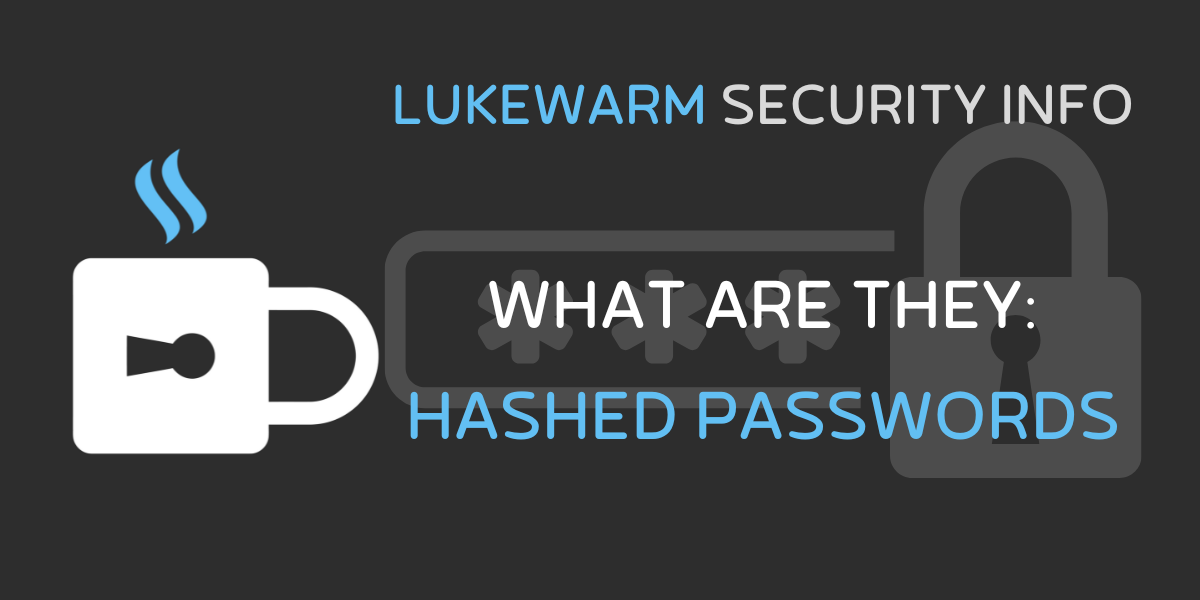What are they: Hashed Passwords?

When looking around at cyber security concepts, one term that is used often is hashed password or to hash something. What this is, in a basic overview, is a one-way encrypted version of something.

Plaintext describes text that is human readable / understandable, such as (hopefully) this blog post, or the word “password”.
Hashed describes text that has gone through a hashing function and is typically a little less human readable, such as 5f4dcc3b5aa765d61d8327deb882cf99.
What is a hashing function?
Hashing functions (or hashing algorithms) are functions that take some type of data, run it through a series of complex mathematical steps, and spit out a result that looks like a weird string of letters and numbers.
Some of the most common hash functions include SHA256, SHA512, MD5 and many others.
Hash functions, however, are much more complex than just taking in data and spitting out a result. There are several rules that a hash function must live by for it to be used / counted as a hash function.
These rules / attributes a hash function must have are:
- Repeatable
- Unique
- Unpredictable
- Irreversible
- Consistent
What do these rules/attributes mean?
Repeatable
The repeatable attribute means that every time the same text is hashed with that hash function, it gets the same result. This should be the same result, independent of the time of day, computer hardware, operating system etc.
For example, if I run the plaintext “password” through the MD5 hashing algorithm, it should always produce the result 5f4dcc3b5aa765d61d8327deb882cf99.
Unique
Hash results must all be unique, meaning that (to the best of their ability), there should ideally only be one input to produce that result.
Since it’s mathematically impossible to only have one input for each possible output (there are an infinite number of possible inputs and a finite number of possible outputs), as long as another input that produces the same output (collision value) cannot be predicted/ calculated, this is ok.
Having multiple inputs that produce the same hash output is called a hash collision.
Unpredictable
Hash results should not be able to be calculated or predictable, meaning that there should be no correlation between the hash of password1 and password2 for example. Irreversible It should not be possible to find the original input of a hash function based on its output. In essence, this should be a one-way encryption, and should not be able to be decrypted / reversed.
Note: Rainbow Tables are not decrypting / reversing the input since it only shows a possible input for the same output
A common way for someone to find the reverse of a hash output is through what is known as a Rainbow Table. These are databases or tables filled with various inputs, and their corresponding hash outputs.
To try this for yourself, paste in 5f4dcc3b5aa765d61d8327deb882cf99into your search engine, and you should be able to find the result quite quickly.
(Hint: It’s the MD5 hash for “password”)
Consistent
This is more about the output of a hash, while it should be repeatable, ALL hash outputs should be the same length. This is part of the unpredictable nature of a hash, ensuring that all hash outputs are just as difficult to crack as each other.
All hashes have their own Fixed-length Output. For example, the MD5 hash has a fixed-length output of 128 bits (or 32 hexadecimal digits). Also, all hex outputs are in hexadecimal digits, meaning that they are a combination of (lowercase OR UPPERCASE) letters and numbers.
Where are hashed passwords used?
Hashed passwords (ideally) are used whenever a website or server stores your password for login. What happens, is that when you register for a website, the website takes a hash of the password you typed in, and then stores that in their database, next to your username.
Why?
If a website / company gets hacked (for example), the attackers can only grab the hashed passwords, meaning they don’t know what the actual password was (irreversible attribute).
Since one of the attributes of a hashed password is that it’s repeatable, every time we type in our password to the website to log in, the password that we typed in is hashed the same way as it was originally, and compared to what is stored on the websites database. If they match (uniqueness attribute saves us here), then the user entered the correct password, if they don’t, then their password was incorrect.
How do we secure a hashed password even further?
With Rainbow Tables and the like threatening the irreversible nature of hashed password, security engineers have become creative in their attempts to counter these tables, namely with salt and pepper.

Salt
A Salt (not the edible kind) is a random string of characters added to the start/end of a users password before it’s hashed. For example, if I registered an account on a website, and typed in my password as “password”, the website would take that password, add (for example) “supersecretcodethatwasrandomlygenerated” to the start of it (so the password being hashed is “supersecretcodethatwasrandomlygeneratedpassword”), and then they hash that new password and store it in the database.
Then, whenever someone tries to log into that account, they type in their password, the Salt is added to the start of it, and then it’s compared to the hash in the database.
Salt’s are typically consistent across all users, meaning that typically a website would use one randomly generated salt on all passwords.
Pepper
Pepper (again, not the edible kind) is similar to a salt, and works the same way, except it only applies to one user, meaning that each user would have a different pepper.
Typically, these are stored on a database, near username and hashed password, and are added to the password before it’s hashed as well as the salt.

